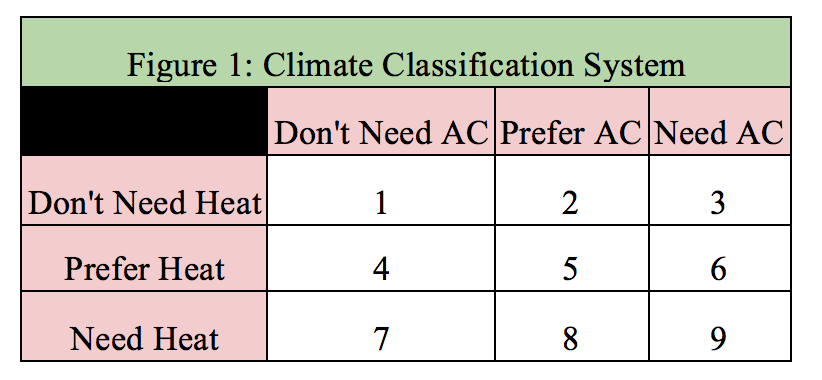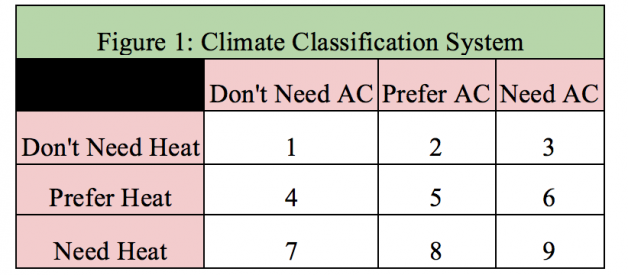Where in the world is the temperature perfect year round? Growing up in a place like Lexington, Kentucky, you get used to cold, icy winters and hot, humid summers. When those delicious few weeks of perfect weather arrive in the spring and fall, the city briefly bursts to life with block parties, cookouts, and art fairs. Outside of these brief periods, we spend the vast majority of our lives inside, with the windows up, and either the heat or AC cranked up. For most of my life, having eventually moved to DC and now living in New Jersey, I took this order of things for granted. And then I lived in Guatemala City.
In Guatemala City, almost nobody owns an AC or heater. The temperature hovers around 70 fahrenheit year round. When the temperature dips down to 60 at night, Guatemalans may squirm and put on a heavy jacket ? an entertaining scene coming from New Jersey?s winters ? but beyond that, Guatemala?s climate is perfect and its residents know it. This extremely temperate climate leads to all sorts of magical results: Windows are open all year round and homes are built to accommodate natural heating and cooling. Most malls, stores, and restaurants are completely open to the outside, with little more than shelter from rain and a gate at night. Guatemalans, despite the serious concerns over crime in the city, spend huge chunks of their lives outside eating, socializing, and working.
Upon returning home, I decided to sit down and identify all these magical places where the temperature is perfect year round. Below is a short section explaining how I did it and the assumptions that I made. This is important, because you may disagree with my assumptions and want to make your own map. But if you aren?t interested in this kind of thing, just skip down to the ?What Did I Find?? section.
This study breaks out most major cities in the world based on a) whether you would need, prefer, or not need heat if you lived there, and b) whether you would need, prefer, or not need AC if you lived there. The categories work as follow (also see Figure 1):
- Category 1: You definitely don?t need AC or heat. The temperature is perfect year round!
- Category 2: You definitely don?t need heat, but if you can afford it you will probably prefer to have AC for the really hot months.
- Category 3: You definitely don?t need heat, but you will definitely need AC.
- Category 4: If you can afford it, you will probably prefer to have heat for the colder months, but you definitely don?t need AC.
- Category 5: If you can afford it, you will probably prefer to have heat for the colder months and AC for the warmer months.
- Category 6: If you can afford it, you will probably prefer to have heat for the colder months, and you will definitely need AC for the warmer months.
- Category 7: You definitely need heat, but you definitely don?t need AC.
- Category 8: You definitely need heat, and if you can afford it, you will probably prefer to have AC for the warmer months.
- Category 9: You will definitely need heat and AC. As far as I am concerned, this is the worst kind of place, temperature-wise.
 Graphic design is my passion.
Graphic design is my passion.
Now for a somewhat complicated explanation on categorizing. Using Wikipedia data on the climate of most major cities in the world, I determined whether you need, prefer, or don?t need AC and heat in each city. This data is collected from a variety of sources and in many cases ? particularly in developing countries ? may not be 100% accurate. But given its ease of access and relative consistency in formatting, this allowed me to rapidly collect the data. If I left your city out, you can easily use my method to classify your own city.
To determine whether you need, prefer, or don?t need AC, I used two data points: First, I collected the daily mean temperature in the warmest month ? in the northern hemisphere, typically July or August, in the southern hemisphere, typically January or February. Second, I collected the average high temperature in the warmest month.
Using these data, I classified cities into three groups: First, if a city?s daily mean in the warmest month stayed below 80 fahrenheit (going forward, all temperature data is in fahrenheit) and its average high in this month was below 82.5, residents of the city probably don?t need AC. On the rare occasion when it gets really warm in these cities, it?s easily to cool off with a fan, open window, or glass of ice water. Second, if a city?s daily mean in the warmest month was north of 80 but south of 85, or its average high in this month stayed below 87.5, residents of the city will probably prefer AC in the warmest months. You can get by without AC most of the time, but during the warmest months of the year, you?re likely going to wish you had it. Third, if a city?s daily mean creeps above 85 in its warmest month, or if the average high in this month creeps north of 87.5, residents of the city need AC. Do people in poverty live without AC in these areas? Certainly. But if you are old, in poor health, or just don?t like sitting around drenched in sweat, you will want it.
To determine whether you need, prefer, or don?t need heat, I used other two data points: First, I collected the daily mean temperature in the coldest month ? reverse the northern and southern hemispheres from the last paragraph. Second, I collected the average low temperature in the coldest month.
Again, I classified cities into three groups: First, if a city?s daily mean in the coldest month stayed above 55 and its average low in this month was never below 45, residents of the city probably don?t need heat. Whenever it occasionally gets chilly, you can easily solve the problem by bundling up, staying inside, and making hot chocolate. Second, if a city?s daily mean in the coldest month was below 55 but above 45, or its average low in this month fellow below 45 but stayed above 35, residents of the city will probably prefer heat in the coldest months. Third, if a city?s daily mean falls below 45 in its coldest month, or if the average low in this month falls below 35, residents of the city need heat. This probably goes without explanation: even if it?s limited to one part of the year, freezing is freezing, and you?re going to need heat when it happens.
Now for four hedges to head off annoying negative comments:
- First, this study doesn?t include humidity, which matters a whole heck of a lot for comfort. Even if the temperature isn?t so high, an AC can be a godsend if the humidity is high. Humidity may have potentially impacted these results at the margins, indeed, but by and large, humidity is bundled into temperature.
- Second, in every city, there is extreme cold and extreme heat from time to time. ?Average? highs and lows are, after all, the average. Even Guatemala City, which ? spoiler alert ? I classify as having a perfect temperature, has a record high of 93. You?re probably going to want AC on that weird day. Regardless, most Guatemala City residents don?t have AC, which gets at my point: I am really only interested in how things are 95% of the time. If 5% of the time you are uncomfortable, well hey, that?s life.
- Third, these classifications reflect what I take to be normal preferences. Most humans seem to like the temperature to stay between 55 and 82.5. Maybe you?re not normal ? you might like it a little colder, you might like it a little warmer. If that?s the case, do your own study! All of my data is publicly available in this spreadsheet and you can easily reclassify it and plug the new data into Google MyMaps. In fact, if you do that, please share it in the comments.
- Fourth and finally, this study is only looking at year-round temperature. This should not be taken to indicate which cities are good and bad overall. There are plenty of non-temperature reasons to want to, for example, avoid Caracas (Classification 1) and move to Madrid (Classification 9).
What Did I Find?
Click the thing next to the title to see the legend. Click on any city to see my data.
The Perfect Cities. Without further ado, here are the 13 cities where the temperature is wonderful year round, in alphabetical order:
- Antananarivo, Madagascar
- Bogot, Colombia
- Caracas, Venezuela
- Durban, South Africa
- Guatemala City, Guatemala
- Lima, Peru
- Mexico City, Mexico
- Nairobi, Kenya
- Port Elizabeth, South Africa
- Quito, Ecuador
- San Diego, California
- So Paulo, Brazil
- Sydney, Australia
In other words, if you are looking to live somewhere where you don?t need AC or heat at any point in the year, you should check out southern California, the highlands of Central and South America, parts of southern and eastern Africa, and southeast Australia and New Zealand.
The Not-So-Great Areas. I don?t like being mean to cities, so I?ll just share the poor climate regions and you can look at the map above if you would like more data. They are marked with a red ?X? and fall under Classification 9. The regions where you will need both AC and heat are the southeast United States, Central Asia, and northern East Asia.
One or the Other. In most of Europe, Russia, and Canada, you will need heat but not AC. In most of the Caribbean, West Africa, Middle East, and southeast Asia, you will need AC but not heat. If you are just interested in energy use, stick with the first group; in the former, you really just need heat in the winter, while in the latter, you will often need AC year round. That said, cold weather is much more dangerous than warm weather, both of terms of physical and mental health, so you decide.
Something That Annoys Me. Europeans really like to make fun of Americans for using a lot of AC. And it?s true, Americans probably use a little bit more AC than they need. But in most U.S. cities outside of the northeast or West Coast, you absolutely need AC in the summer, and once it?s installed, it?s easy to use it a little too much. North of the Mediterranean, on the other hand, having AC for anything beyond heat waves is silly.
The Little Utopias. For this study, I chose to look at exclusively at major world cites?plus my hometown of Lexington. My reason for this is simple and personal: I made this index to find places that I might like to call home, and I want to live in a large, global city. That said, in doing this research, I found a number of small, often extremely expensive locations that meet my criteria for perfect temperature that I should share. Beyond the cities and regions I discussed above, the following places appear to fit my criteria: the Canary Islands, Hawaii, and parts of the Aegean Sea.
Concluding Thoughts
If you?re not careful, it?s easy for life to start looking like an unending series of grand crises and existential outrages. In our current environment, with these attitudes amplified by the megaphone of social media, I think there is added value in undertaking small projects and appreciating small joys. For all the silliness going on in the world, a nice, sunny, 70 day is a valuable thing. Supper on the back deck with family, a walk around the neighborhood with a friend, enjoying a good book and a good beer on the front porch late into the evening; these are the little moments that make life meaningful. Temperature is certainly important. But the thing that above all makes these moments possible might be state of mind. That, unfortunately, can?t be mapped.


